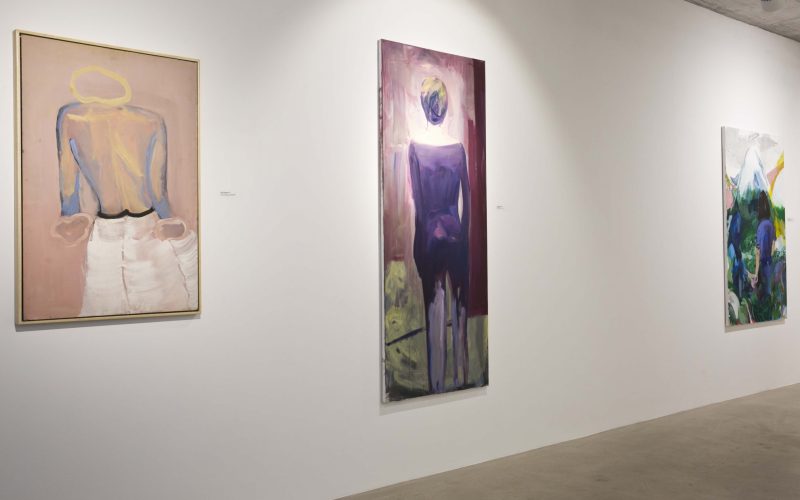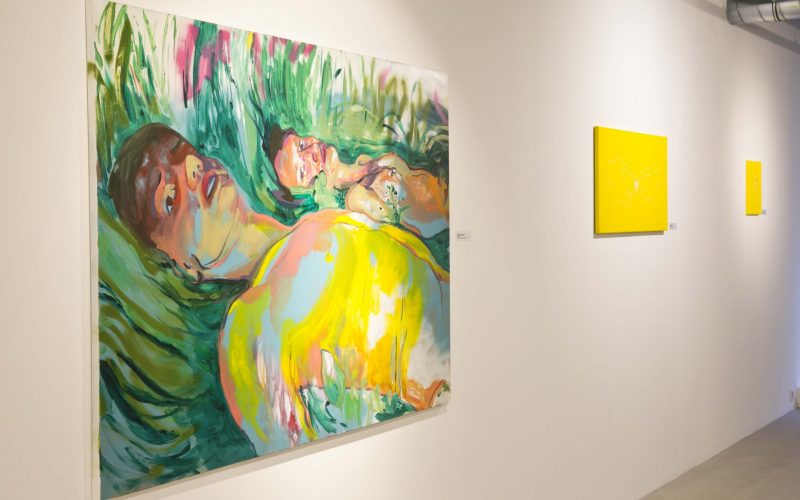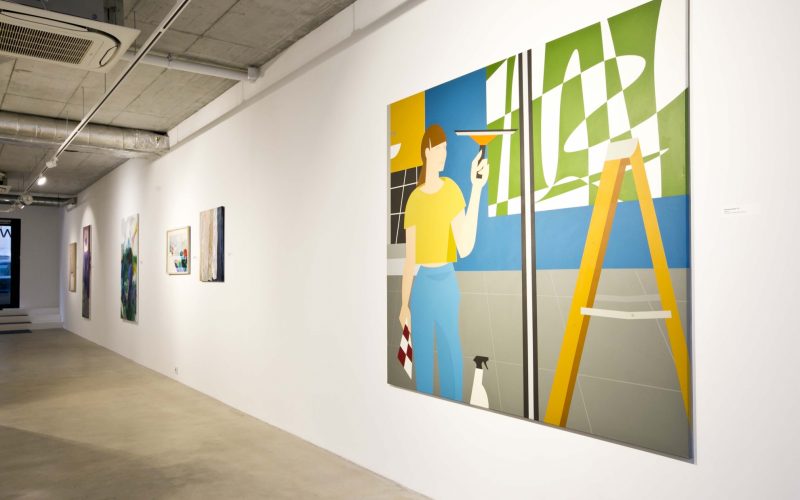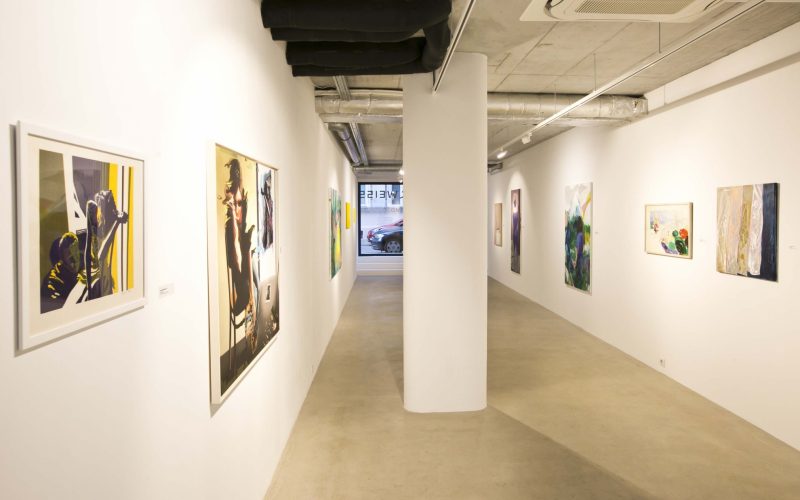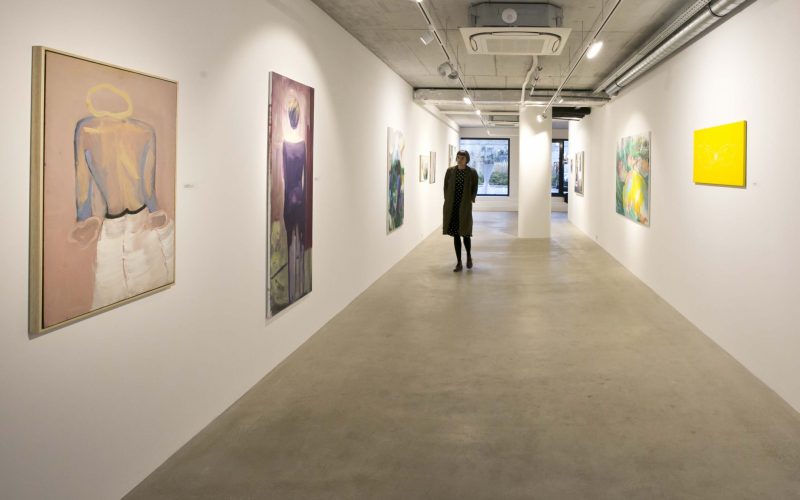08 MAR - 22 APR 2017
IWD (International Women's Day) - painting by contemporary women
Klára Bočkayová (1948), Veronika Rónaiová (1951), Jana Farmanová (1970), Dorota Sadovská (1973), Alexandra Barth (1989) a Kristína Bukovčáková (1991)
Curator: Ľuboš Lehocký
MDŽ (the Slovak acronym for International Women’s Day) is the first of a series of periodically prepared exhibitions focused on presentation of Slovak women artists, and later also international artists, in the White & Weiss gallery. The present exhibition is a selective, generational cross-section and an exploration into the artwork of six contemporary Slovak artists.
Obviously, the first thing presenting itself for discussion is femininity: paintings by women and of women and viewing the works of these artists through feminist optics. Volume V of the Thesaurus of the Slovak Language published in the 1960s, at the time when two of the most experienced artists whose works are presented in this exhibition were starting their creative career, defined non-physiologically comprehended femininity as “a complex of features, signs typical of women (especially softness, emotionality and charm)”. Even while accepting that something such as femininity (alongside masculinity as a sub-category of humanness), not bound just to the physical body, does exist, that dictionary definition is disastrously reducing and inaccurate. Let us pass from what is feminine to what is human.
One of the features that can be observed in the exhibited works, for example, is figurativeness/figuralness (more or less realistic representation of things/the presence of a human figure). All artists work with figures or their fragments. To be more accurate, I should go beyond talking exclusively about figure (as a form) and be more general and talk primarily about humans. Let us say, Dorota Sadovská undoubtedly is interested in figurativeness, meaning the manners, conventions, context, expressive and semantic capacity and so forth in her visual representation, but there is something else that is essential (not only) to her art. In the painting Adam and Eve (1999) the representation of figures is reduced down to a simple contour, a thin white line against a rich yellow background that brings to the forefront the symbolic archetypal story of seduction, temptation and violation of a taboo and the story of an archetypal relationship of people rather than some kind of female or male figures/forms. Similarly, also in paintings by the other artists we could view the figures as human beings rather than figures of men or women.
In the exhibited works by all six artists various degrees of visual stylization, deformation, expressiveness or departure from the veristic/realistic representation of the depicted reality were used. Whether the ways in which this departure comes into being embrace something feminine, and if so, it is not obvious what it actually is. For example, the brush work by Kristína Bukovčáková can be described as just giving hints, as sketchy, fluid, light, expressive strokes and colours, but answering the question of how that is related to femininity or how anything in her paintings is related to femininity is a challenging task. What is feminine about viewing a couple’s figures in a natural setting and turning their backs on the viewers; or looking at naked bodies of a man and a woman whose view is directed out of the picture or staring at nothing? Tragedy (2015) does not bring femininity to our minds; it brings especially tension, unrest, concern over something we just suspect, something that is not pleasant for sure.
An array of sensations from unrest and melancholy to pondering or dreaming also appears in the works by other artists and it is associated, inter alia, with the presence of the figure of a woman in the picture. Still, Head in the Clouds (Jana Farmanová, 2000), by the way, is a head that may belong to a man. Does the grammatical gender in the title of the picture A Pompeii Woman I. (2013) include something utterly feminine? Even if it does, thoughts of other people from Pompeii including the Pompeii woman’s father will not stop haunting us. The reason is that this is primarily a story, a generally human tragedy that struck all regardless of their gender or anything else.
Veronika Rónaiová painted the picture Lonely in 1972, approximately at the age of the youngest exhibiting artists. The MDŽ exhibition in the White & Weiss gallery presents thus far un-exhibited graphics that preceded this picture and also a newer work called Self-identification VI. (2004/2006) that draws from the original motif of a woman sitting with her head down, resting on her forearm. The lonely figure of the woman in the picture has shifted in time from the origin of Rónaiová’sgraphic piece in a private setting to the premises of a gallery where self-interpretations of the Lonely that have arisen in the meantime have propagated in a meta-referential manner. The motif of the picture, and all it represents, as well as the work alone as an artefact, are something moving within changing contexts (of a person’s life, the other works by the artist, institutional practices, etc.). The self-identification process does not concern the artist alone. Any person looking at the picture can identify themselves with the loneliness, regardless of the gender of the artist, of the depicted figure, of their own gender and also regardless of when the picture was made or how many women artists have their works in collections of museums and similar institutions. Loneliness and attempts at self-identification (finding one’s place in the sun) are something that we all experience regardless of our age, gender/sex and social status.
Just like works by Rónaiová, Sadovská and Farmanová, the art by Klára Bočkayová is also presented in the exhibition not only through a contemporary work but also through an older picture dating back to the time to when the artist was of an age at which the youngest artists, Barth and Bukovčáková, are presenting their works in the exhibition. Bočkayová has an older picture The Sea Wants to be Like the Sky (1974) and a more contemporary painting, Pale Dream (2016). A certain shift is noticeable between these works. Embroidery, stereotypically considered an attribute of femininity and banality, is literally physically present in the painting of the 1970s; it is the picture’s groundwork. In the newer picture, the embroidery is referred to through frottage and own technique just through an anamorphic, in variations re-appearing shape. The physical shift, motion of surfaces handled during painting, is an important means, a technique that yielded the visual effect. Yet, symbolically and already in the surface of the respective (including the older one) picture, the issue is a shift from an embroidery to painting, from a stereotype to the unconventional, from a “woman’s job” (a canvas from village or town-dwellers’ kitchens) to a generally artistic dimension. The artist and her works in a way actually point out that there is nothing such as some kind of primitive woman’s creative designation that means doing embroidery, not painting. The truth, of course, is that women were for a long time often denied of opportunities to carry out free artistic creativity yet it also appears that just like Klára Bočkayová they managed to use visual art to add value to and shift the meanings of motifs from embroidery so that in society, during its development, at times absurdly-firm designations of the definitions of masculinity and femininity and the positions of men and women also shifted, eroded and underwent reform. This is attested by a glance at the current exhibition programs of contemporary galleries.
If a hundred years after an apocalypse a survivor (woman or man) discovers, let us say, the picture The Smokers’ Break (2015) by Alexandra Barth in the ruins of a gallery, would their first thoughts be about the gender of the artist, would they ponder about whether it is a painting of a then contemporary woman or would they be touched primarily by the scene of a person, immersed in thought for a while, who, just like they, took a while to think perhaps about the next day or perhaps about the futile effort at work and more? And will it matter whether the person looking at the canvas is a woman or a man?
I do not really know whether there is something typically feminine in the mentioned themes, motifs and ways of their visual articulation and I do not even know what “typically feminine” means. What perhaps is more important is whether the work is good or not. As a matter of fact, artists alone do not reduce the human and artistic down to masculine or feminine. We also can avoid that if we want. It may be quite useful at times when we abandon the insistent effort to conceptualize the gender of the artist and her work or the attempts to view artwork through gender-based optics. We avoid that, almost always by the way, when we have to deal with works by a man.
We perceive art primarily as something human and only then, if at all, arrives the reflection of something that may be related to femininity, no matter what that may mean. It seems that at the point where something really humanly substantial and basal is concerned, sex/gender does not really matter. And it may also be that only I, an ignorant, insensitive man perceives it that way. How do you see these things?
Svätá Lucia
Saint Lucia
2017, acrylic on canvas, 35 x 30 cm
Hora
Mountain
2014, acrylic on canvas, 150 x 100 cm
Tragédia
Tragedy
2015, acrylic and spray on canvas, 120 x 180 cm
Výklad
Showcase
2016, acrylic on canvas, 165 x 180 cm
Fajčiarska prestávka
Smoker´s Break
2015, acrylic on canvas, 120 x 100 cm
Pompejanka I.
A Pompeii Woman I.
2013, oil on canvas, 175 x 75 cm
Hlava v ooblakoch, z cyklu Telovky
Head in the Clouds, from the searies Body colour paintings
2000, acrylic on canvas, 100 x 70 cm
More chce byť ako nebo
The Sea Wants to be Like the Sky
1974, textile on fibreboard, acrylic, glass fragment, 75,8 x 50 cm
Bledý sen
Pale Dream
2016, acrylic on canvas, 70 x 65 cm
Autoidentifikácia VI.
Self-identification VI.
2004/2006, oil and PC-print on canvas, 80 x 110 cm
Adam a Eva
Adam and Eve
1999, acrylic on canvas, 50 x 100 cm
Bez názvu
Untitled
1972, linocut on paper, 33 x 40 cm

